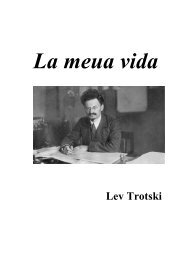ecause their diminutive capital does not suffice for the scale on which Modern Industry iscarried on, and is swamped in the competition with the large capitalists, partly because theirspecialised skill is rendered worthless by new methods <strong>of</strong> production. Thus the proletariat isrecruited from all classes <strong>of</strong> the population.The proletariat goes through various stages <strong>of</strong> development. With its birth begins its strugglewith the bourgeoisie. At first the contest is carried on by individual labourers, then by theworkpeople <strong>of</strong> a factory, then by the operative <strong>of</strong> one trade, in one locality, against theindividual bourgeois who directly exploits them. They direct their attacks not against thebourgeois conditions <strong>of</strong> production, but against the instruments <strong>of</strong> production themselves; theydestroy imported wares that compete with their labour, they smash to pieces machinery, they setfactories ablaze, they seek to restore by force the vanished status <strong>of</strong> the workman <strong>of</strong> the MiddleAges.At this stage, the labourers still form an incoherent mass scattered over the whole country, andbroken up by their mutual competition. If anywhere they unite to form more compact bodies,this is not yet the consequence <strong>of</strong> their own active union, but <strong>of</strong> the union <strong>of</strong> the bourgeoisie,which class, in order to attain its own political ends, is compelled to set the whole proletariat inmotion, and is moreover yet, for a time, able to do so. At this stage, therefore, the proletariansdo not fight their enemies, but the enemies <strong>of</strong> their enemies, the remnants <strong>of</strong> absolute monarchy,the landowners, the non-industrial bourgeois, the petty bourgeois. Thus, the whole historicalmovement is concentrated in the hands <strong>of</strong> the bourgeoisie; every victory so obtained is a victoryfor the bourgeoisie.But with the development <strong>of</strong> industry, the proletariat not only increases in number; it becomesconcentrated in greater masses, its strength grows, and it feels that strength more. The variousinterests and conditions <strong>of</strong> life within the ranks <strong>of</strong> the proletariat are more and more equalised,in proportion as machinery obliterates all distinctions <strong>of</strong> labour, and nearly everywhere reduceswages to the same low level. The growing competition among the bourgeois, and the resultingcommercial crises, make the wages <strong>of</strong> the workers ever more fluctuating. The increasingimprovement <strong>of</strong> machinery, ever more rapidly developing, makes their livelihood more andmore precarious; the collisions between individual workmen and individual bourgeois take moreand more the character <strong>of</strong> collisions between two classes. Thereupon, the workers begin to formcombinations (Trades’ Unions) against the bourgeois; they club together in order to keep up therate <strong>of</strong> wages; they found permanent associations in order to make provision beforehand forthese occasional revolts. Here and there, the contest breaks out into riots.Now and then the workers are victorious, but only for a time. The real fruit <strong>of</strong> their battles lies,not in the immediate result, but in the ever expanding union <strong>of</strong> the workers. This union is helpedon by the improved means <strong>of</strong> communication that are created by modern industry, and that placethe workers <strong>of</strong> different localities in contact with one another. It was just this contact that wasneeded to centralise the numerous local struggles, all <strong>of</strong> the same character, into one nationalstruggle between classes. But every class struggle is a political struggle. And that union, toattain which the burghers <strong>of</strong> the Middle Ages, with their miserable highways, required centuries,the modern proletarian, thanks to railways, achieve in a few years.This organisation <strong>of</strong> the proletarians into a class, and, consequently into a political party, iscontinually being upset again by the competition between the workers themselves. But it everrises up again, stronger, firmer, mightier. It compels legislative recognition <strong>of</strong> particularinterests <strong>of</strong> the workers, by taking advantage <strong>of</strong> the divisions among the bourgeoisie itself. Thus,the ten-hours’ bill in England was carried.Altogether collisions between the classes <strong>of</strong> the old society further, in many ways, the course <strong>of</strong>development <strong>of</strong> the proletariat. The bourgeoisie finds itself involved in a constant battle. At firstwith the aristocracy; later on, with those portions <strong>of</strong> the bourgeoisie itself, whose interests havebecome antagonistic to the progress <strong>of</strong> industry; at all time with the bourgeoisie <strong>of</strong> foreigncountries. In all these battles, it sees itself compelled to appeal to the proletariat, to ask for help,and thus, to drag it into the political arena. The bourgeoisie itself, therefore, supplies theproletariat with its own elements <strong>of</strong> political and general education, in other words, it furnishesthe proletariat with weapons for fighting the bourgeoisie.
Further, as we have already seen, entire sections <strong>of</strong> the ruling class are, by the advance <strong>of</strong>industry, precipitated into the proletariat, or are at least threatened in their conditions <strong>of</strong>existence. These also supply the proletariat with fresh elements <strong>of</strong> enlightenment and progress.Finally, in times when the class struggle nears the decisive hour, the progress <strong>of</strong> dissolutiongoing on within the ruling class, in fact within the whole range <strong>of</strong> old society, assumes such aviolent, glaring character, that a small section <strong>of</strong> the ruling class cuts itself adrift, and joins therevolutionary class, the class that holds the future in its hands. Just as, therefore, at an earlierperiod, a section <strong>of</strong> the nobility went over to the bourgeoisie, so now a portion <strong>of</strong> thebourgeoisie goes over to the proletariat, and in particular, a portion <strong>of</strong> the bourgeois ideologists,who have raised themselves to the level <strong>of</strong> comprehending theoretically the historical movementas a whole.Of all the classes that stand face to face with the bourgeoisie today, the proletariat alone is areally revolutionary class. The other classes decay and finally disappear in the face <strong>of</strong> ModernIndustry; the proletariat is its special and essential product.The lower bourgeoisie, the small manufacturer, the shopkeeper, the artisan, the peasant, all thesefight against the bourgeoisie, to save from extinction their existence as fractions <strong>of</strong> thebourgeoisie. They are therefore not revolutionary, but conservative. Nay more, they arereactionary, for they try to roll back the wheel <strong>of</strong> history. If by chance, they are revolutionary,they are only so in view <strong>of</strong> their impending transfer into the proletariat; they thus defend nottheir present, but their future interests, they desert their own standpoint to place themselves atthat <strong>of</strong> the proletariat.The “dangerous class,” [lumpenproletariat] the social scum, that passively rotting massthrown <strong>of</strong>f by the lowest layers <strong>of</strong> the old society, may, here and there, be swept into themovement by a proletarian revolution; its conditions <strong>of</strong> life, however, prepare it far more for thepart <strong>of</strong> a bribed tool <strong>of</strong> reactionary intrigue.In the condition <strong>of</strong> the proletariat, those <strong>of</strong> old society at large are already virtually swamped.The proletarian is without property; his relation to his wife and children has no longer anythingin common with the bourgeois family relations; modern industry labour, modern subjection tocapital, the same in England as in France, in America as in Germany, has stripped him <strong>of</strong> everytrace <strong>of</strong> national character. Law, morality, religion, are to him so many bourgeois prejudices,behind which lurk in ambush just as many bourgeois interests.All the preceding classes that got the upper hand sought to fortify their already acquired statusby subjecting society at large to their conditions <strong>of</strong> appropriation. The proletarians cannotbecome masters <strong>of</strong> the productive forces <strong>of</strong> society, except by abolishing their own previousmode <strong>of</strong> appropriation, and thereby also every other previous mode <strong>of</strong> appropriation. They havenothing <strong>of</strong> their own to secure and to fortify; their mission is to destroy all previous securitiesfor, and insurances <strong>of</strong>, individual property.All previous historical movements were movements <strong>of</strong> minorities, or in the interest <strong>of</strong>minorities. The proletarian movement is the self-conscious, independent movement <strong>of</strong> theimmense majority, in the interest <strong>of</strong> the immense majority. The proletariat, the lowest stratum <strong>of</strong>our present society, cannot stir, cannot raise itself up, without the whole superincumbent strata<strong>of</strong> <strong>of</strong>ficial society being sprung into the air.Though not in substance, yet in form, the struggle <strong>of</strong> the proletariat with the bourgeoisie is atfirst a national struggle. The proletariat <strong>of</strong> each country must, <strong>of</strong> course, first <strong>of</strong> all settle matterswith its own bourgeoisie.In depicting the most general phases <strong>of</strong> the development <strong>of</strong> the proletariat, we traced the more orless veiled civil war, raging within existing society, up to the point where that war breaks outinto open revolution, and where the violent overthrow <strong>of</strong> the bourgeoisie lays the foundation forthe sway <strong>of</strong> the proletariat.Hitherto, every form <strong>of</strong> society has been based, as we have already seen, on the antagonism <strong>of</strong>oppressing and oppressed classes. But in order to oppress a class, certain conditions must beassured to it under which it can, at least, continue its slavish existence. The serf, in the period <strong>of</strong>serfdom, raised himself to membership in the commune, just as the petty bourgeois, under theyoke <strong>of</strong> the feudal absolutism, managed to develop into a bourgeois. The modern labourer, onthe contrary, instead <strong>of</strong> rising with the process <strong>of</strong> industry, sinks deeper and deeper below the
- Page 4: égime, which has been through its
- Page 7: sins of all state forms. That this
- Page 13 and 14: It has not occurred to any one of t
- Page 15 and 16: gradually accumulated small capital
- Page 17 and 18: from this nonsensical ‘prehistory
- Page 19 and 20: property: the nucleus, the first fo
- Page 21 and 22: which produces in all nations simul
- Page 23 and 24: [8. The Inconsistency of the Ideali
- Page 25 and 26: The ‘essence’ of the fish is it
- Page 27 and 28: hence of the relationships which ma
- Page 29 and 30: labour. In the first case, therefor
- Page 31 and 32: production and commerce soon calls
- Page 33 and 34: period begins with the Navigation L
- Page 35 and 36: more advanced countries, still have
- Page 37 and 38: over against the individuals, so th
- Page 39 and 40: eality is only a product of the pre
- Page 41 and 42: never became more than a city; its
- Page 43 and 44: Only at this stage does self-activi
- Page 45 and 46: Modern industry has established the
- Page 47: these crises, there breaks out an e
- Page 51 and 52: abolish that; the development of in
- Page 53 and 54: For the rest, nothing is more ridic
- Page 55 and 56: III. Socialist and Communist Litera
- Page 57 and 58: conscious of having overcome “Fre
- Page 59 and 60: The undeveloped state of the class
- Page 61 and 62: The Paris CommuneAddress to the Int
- Page 63 and 64: priests were sent back to the reces
- Page 65 and 66: pregnant. In the full consciousness
- Page 67 and 68: subjected Versailles and the rest o
- Page 69 and 70: The Eighteenth Brumaire of Louis Bo
- Page 71 and 72: For the rest, every fair observer,
- Page 73 and 74: that here “bourgeois republic”
- Page 75 and 76: Eternalization of historic relation
- Page 77 and 78: and becomes a direct object and ser
- Page 79 and 80: each supplies the other with its ob
- Page 81 and 82: generally. The question evidently b
- Page 83 and 84: is thus the only reality, the movem
- Page 85 and 86: smudge over all historical differen
- Page 87 and 88: elations. Thus e.g. the relation of
- Page 89 and 90: a rise of wages, because every reac
- Page 91 and 92: equally spent upon all articles of
- Page 93 and 94: Apart from some years of failing ha
- Page 95 and 96: enable a currency to adapt itself t
- Page 97 and 98: Smith and his French predecessors h
- Page 99 and 100:
conditions of production, with a gi
- Page 101 and 102:
in a commodity constitutes its valu
- Page 103 and 104:
y working which the working man wou
- Page 105 and 106:
just seen that the surplus value co
- Page 107 and 108:
increased value of his labour, like
- Page 109 and 110:
altogether, is sure to have his wag
- Page 111 and 112:
theory, which consists in putting a
- Page 113 and 114:
Preface to A Contribution to the Cr
- Page 115 and 116:
Capital, Volume I (1867)From the Pr
- Page 117 and 118:
A use value, or useful article, the
- Page 119 and 120:
imposed necessity, without which th
- Page 121 and 122:
embodiments of one identical social
- Page 123 and 124:
abstract. The twofold social charac
- Page 125 and 126:
ased on the production of commoditi
- Page 127 and 128:
Capital Vol. III. Chapter 2. The Ra
- Page 129 and 130:
specific relationship to surplus-va



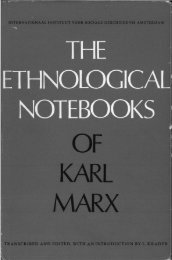

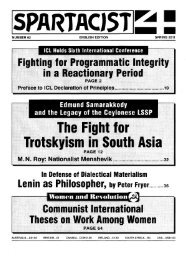

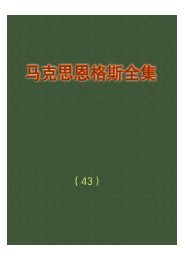
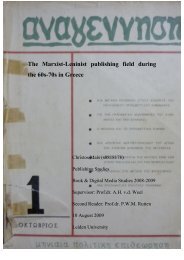

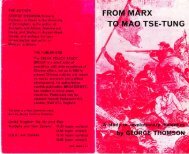

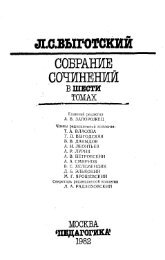
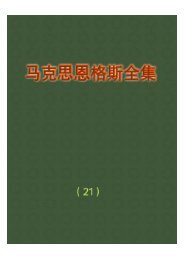
![tyf Enf=O=n]lgg](https://img.yumpu.com/47584932/1/190x245/tyf-enfonlgg.jpg?quality=85)
